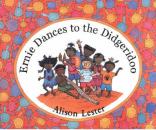AustLit
Units Teaching this Work
| Text | Unit Name | Institution | Year |
|---|---|---|---|
y
 Ernie Dances to the Didgeridoo : For the Children of Gunbalanya
Alison Lester
(illustrator),
Sydney
:
Hodder Headline
,
2000
Z14074
2000
single work
picture book
children's
(taught in 1 units)
Ernie Dances to the Didgeridoo : For the Children of Gunbalanya
Alison Lester
(illustrator),
Sydney
:
Hodder Headline
,
2000
Z14074
2000
single work
picture book
children's
(taught in 1 units)
'When Ernie goes to live in an Aboriginal community in northern Australia, the people, climate, plants and animals are all new to him. Here are his letters to Clive, Nicky, Rosie, Frank, Tessa and Celeste, describing the life he discovers with his new friends in their wild and beautiful land. |
Post-colonial Literature for Children | La Trobe University | 2010 (Semester 2) |


